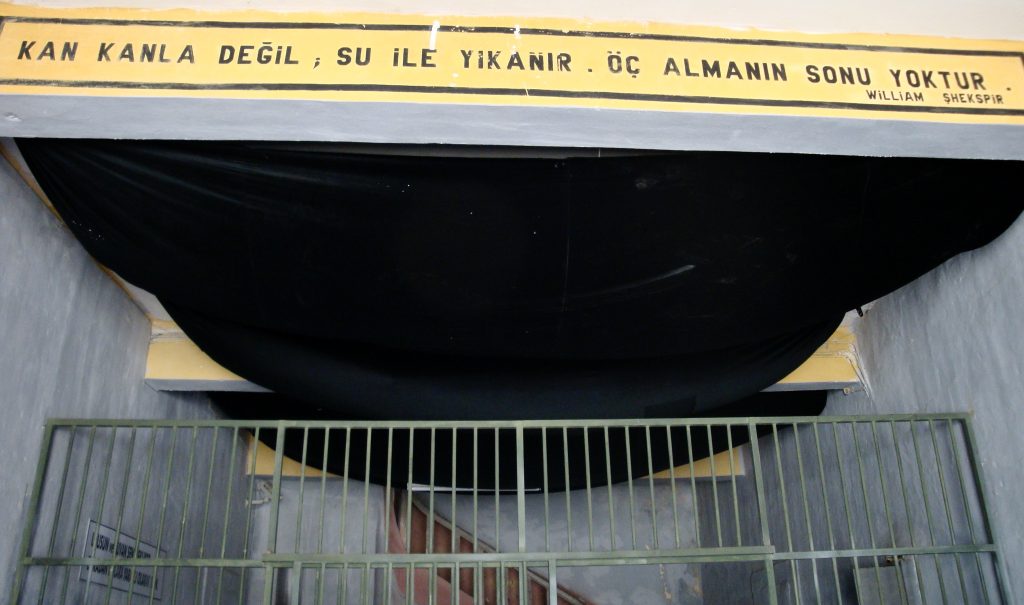Home to Diogenes the Cynic Population: 45,600
Favourite son: Diogenes the Cynic (Ancient Greek philosopher)
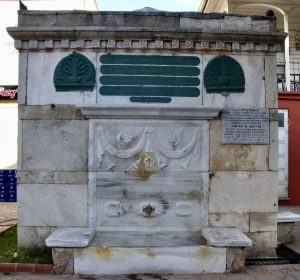
Midway between Amasra and Samsun, Sinop is one of the Black Sea‘s most historically interesting and picturesque towns with a lovely harbour area and a number of fascinating monuments, not least the old prison which has been turned into one of the country’s more unusual tourist attractions.
Sinop Fortress Prison
The Old Prison is tucked up inside a castle that was built by the Selçuks after they captured the city in 1214. As so often, they were happy to reuse whatever materials came to hand, which means that today’s prison visitors get to appreciate a patchwork of old stones interspersed with pieces of ancient column.
The prison itself was a much later addition, plonked down in the south part of the castle in 1882, with an extra wing for juveniles added in 1939. In 1979 the buildings were badly burnt in a riot. The prison was finally abandoned in 1997 and fell into the hands of the Ministry of Culture and Tourism who decided to open it to the public.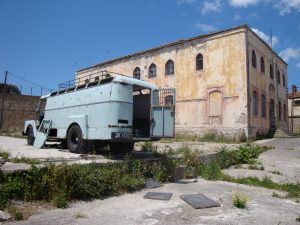
Don’t come here expecting the sort of “interpretation” that would now be commonplace in the UK or the USA. Instead this is for the most part simply a building that has been abandoned, its toilets uncleaned, its doors hanging off their hinges. In the yard of the juvenile wing a prison bus stands with its tyres flat and its doors open.
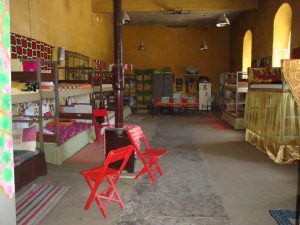 But there are occasional surprises. Through a tiny hole in a bricked-up doorway you can peer at what would once have been a craft workshop, a place where prisoners were taught how to make the wooden boats (kotra) that you’ll still see on sale in the town centre.
But there are occasional surprises. Through a tiny hole in a bricked-up doorway you can peer at what would once have been a craft workshop, a place where prisoners were taught how to make the wooden boats (kotra) that you’ll still see on sale in the town centre.
Another peephole lets you look in on the sort of dormitory cells that were, until quite recently, the prison norm. The barber’s shop also stands untouched, the clothed pin-ups on the wall a reminder of a gentler, more respectful era.
The single most horrific room in the whole complex is a lightless dungeon that must have pre-dated the modern prison.
“The prison guards,” reported the 17th-century travel writer Evliya Çelebi, “were like dragons and the prisoners were all tied from their arms to the iron railings, and each has a bushy moustache where you can hang ten men…they never let anybody escape from there and they don’t even let the birds fly above them.”
The sentences handed down were unimaginably harsh: 130 years for one man, 150 years for another.
And who were the prisoners? Well, during the later period for which records survive the information board informs us that they were “wild murderers and writers and artists who are wanted (sic) to be isolated from the community”. In reality, they included such famous novelists as Sabahattin Ali (1907-48), author of Madonna in a Fur Coat, and perhaps Nazım Hikmet, Turkey’s best loved poet.
News that the prison was to be restored in 2021 did not fill me with joy.
Sinop was once a walled town and considerable lengths of the walls still survive as you’ll see as you come into town.
Its most famous resident was Diogenes the Cynic (404-323 BC), a peculiar philosopher who stripped his life down to the basics until eventually he ended up living inside a barrel in Athens. There he was visited by Alexander the Great who is said to have envied Diogenes. But when he asked the Cynic if there was any favour he could do for him Diogenes simply growled, “Stand out of my light!”
A statue of Diogenes and his famous barrel stands in front of the walls at the point where the isthmus begins.
Walk straight ahead from the statue and keep going until you come to a main square dominated by the Adalet Sarayı (Palace of Justice), then turn left and circle a small park in which stands a monument to 40 local soldiers killed in a surprise Russian attack in 1853 (they are also commemorated by a pretty fountain near the waterfront).
Behind the park the fine Sinop Museum (closed Mondays) contains an unexpectedly impressive collection of 19th-century icons, a reminder of a time when this was a much more cosmopolitan town. There’s also an impressive Roman mosaic depicting the seven Muses, and many more fragments of mosaic scattered about a delightful garden. Here, too, are the remains of a small temple, discovered in 1951, which may or may not have been dedicated to the god Serapis. Assuming that it was, it’s possible that the cult of Serapis spread from here in the fourth century BC until it reached Egypt where it became immensely more important.
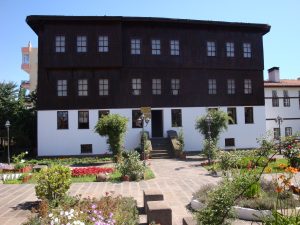 The ethnography collection that used to be housed with the atchaeology has been moved into a huge half-timbered and stone mansion, the Arslan Torun Konağı in a large garden that looks as if it might have walked here from Safranbolu.
The ethnography collection that used to be housed with the atchaeology has been moved into a huge half-timbered and stone mansion, the Arslan Torun Konağı in a large garden that looks as if it might have walked here from Safranbolu.
Nearby in Kuru Çeşme Sokağı a few other old Ottoman houses stand awaiting their second moment in the sun. In Enver Bahadir Caddesi the Ögretmen Evi is an imposing building dating back to 1883 when it was built to serve as a high school (Mekteb-i İdadi).
Sinop’s most impressive mosque is the Alaadin Cami on the main street. Although much modernised, it dates back to 1267 when it was built for the Selçuk grandee, Muinettin Süleyman Pervane, the man also responsible for the Pervane Medresesi in the street behind which has been turned into a showcase for local handicrafts. Both buildings were in the way of a thank-you after he had snatched the town back from the rump Byzantine Empire based in Trebizond (Trabzon) in 1265.
For many people the highlight of a visit to Sinop will be the chance to promenade along the waterfront in the evening before settling down to a fish supper with all the trimmings in one of the harbour restaurants.
The low point is likely to be a visit to the Balatlar Kilisesi (“Palaces Church”), hidden away in a back-street residential area. This enormous complex has to have been more than just a church and some have even suggested that it was the palace of King Mithridates himself. However, within the complex is a large church decorated with late Byzantine frescoes. Offered no protection, these irreplaceable paintings have become a canvas for local taggers who have completely ruined them, a sad commentary on how important heritage is to the authorities.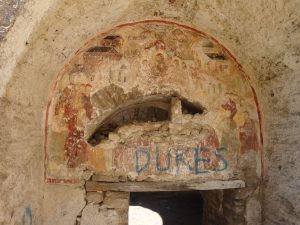
Sleeping
Hotel Melia-Kasım With a fantastic waterside location this big hotel really ought to be the town’s pride and joy. Instead it is a threadbare throwback to the past. Tel: 0368-261 4210
Otel Mola. Tel: 0368-261 1814
Otel Sarı Kadır. Tel: 0368-260 1544
Transport info
Sinop airport is 8km west of the city centre . In summer there are daily flights from İstanbul.
It’s a 12-hour bus ride from İstanbul, rather less from Ankara.
Heading east buses make speedy progress along the Black Sea Highway. Heading west, however, is much slower; using public transport you shouldn’t expect to get much further than İnebolu in a day.
Day trip destinations
